Just need some opinions on contract "verbiage"..
Not trying to bore anyone but would just like to get some opinions on some "verbiage" that was in our contract/proposal as me and the builder are having some disagreement with this.. I have to contact some outside contractors to see what the price difference would be but anyway.. The issue is regarding the staircase, again.. And of course it is an "after the fact" problem as the stairs were just installed.. Our contract reads as follows:
"Interior Steps & Railings - Provide oak stair treads, risers, cap and spindles for main staircases. Provide and install pine steps for basement with pine railing. Provide and
install bessler attic stair"
The issue is with the main staircase.. When the proposal was given and I read it over I liked what it said and my understanding was that the stairs had oak treads, oak risers, oak caps, and oak spindles.. The builder is now trying to say that what he "meant" and what they "normally do" is oak treads with pine risers that they paint.. Now, I am not an english professor but I believe the way that I read it was correct as the "oak" describes the items that follow.. Otherwise it should have read "Provide oak stair treads with pine riser.........etc".. When I called the project manager I could tell that he got very nervous and after a minute or two I heard the ruffling of the papers.. He then said that he needed to speak with the owner but that what he described (oak treads and pine risers) is what they had planned and all that is included.. I recall when we discussed the house we even mentioned full wood stairs being stained.. And now I am trying to think if this has something to do with cutting costs since the stairs came out an extra 6 inches wider then they were supposed to be..
Opinions?
Comments (35)
cpartist
8 years agoHe specifies the pine for the basement but doesn't for the main floor. He goofed and is trying to backtrack now. See if you can work it out amicably. If not, let him know that you'd be happy to see what your RE lawyer says?
Related Professionals
Corpus Christi Architects & Building Designers · Oak Hills Design-Build Firms · Garland Home Builders · Newark Home Builders · Saint Peters Home Builders · Eagan General Contractors · Delhi General Contractors · Groton General Contractors · Harvey General Contractors · Linton Hall General Contractors · Overlea General Contractors · Owosso General Contractors · Panama City General Contractors · Signal Hill General Contractors · Williston General Contractorszorroslw1
8 years agoI agree Oak used at the beginning of the sentence describes all of the items following it unless the description changes to a different type of wood in front of an item.
It doesn't matter what he meant or what they normally do. Your contract specifies Oak for treads, risers, caps and spindles.
User
8 years agolast modified: 8 years agoThere is a lot more to a stair than the cryptic wording you have quoted. A fair interpretation of the intent should consider the rest of the trim such as the wall base, door casing and any open or closed finished stringers since they would normally all intersect at some point and be finished the same. In other words, if the trim is painted, the stair risers and stringers should be painted. If the trim is oak, the risers and stringers should be oak.
Given such a poorly written specification, a photo would be very helpful.
bry911
8 years agolast modified: 8 years agoProvide oak stair treads, risers, cap and spindles for main staircases. - You have a good case if everything else in that list is oak. Specifically, are the spindles oak? If they are, then you can say the obvious intent of the contract is for the risers to be oak. However, if the spindles are not oak then it is hard to say everything in the list was required to be oak.
As far as the law is concerned, when a contract is vague it usually defaults to industry standards. The contract is obviously vague. I really don't know what the standard is in your area so good luck.
Your contract specifies Oak for treads, risers, caps and spindles. You changed the sentence quite a bit. It doesn't really say that at all.
I agree Oak used at the beginning of the sentence describes all of the items following it unless the description changes to a different type of wood in front of an item. - So if I say, "I went shopping for the bathroom today and got ceramic tile, mirror and towels," you assume that my mirror and towels are both ceramic? I mean if an adjective before a list modifies the entire list then all three are ceramic. Or how about, "I went shopping and got a striped shirt, computer and car," are you assuming my car and computer are striped?
You probably have a case. But it is not a slam dunk.
njbuilding143
Original Author8 years agolast modified: 8 years agoI appreciate all the input.. I am still waiting to hear back from the owner of the company on what their opinion is.. Although after everything that has happened their attitudes have become more "pushy" in that they are being called out on their mistakes and don't want to be bothered fixing things.. I guess they are used to people just getting what they get and not questioning things.. Fortunately I visit the site pretty much every day so I see what is going on and catch things fairly quickly..
But back to the stairs.. In regards to Sanford's comments.. We do have white trim throughout the house but not sure what that has to do with anything.. I found a picture online (posted below) that shows all wood stairs (treads, risers, spindles, etc) and they have white baseboard trim around the house.. The other issue is that the agreed price was with the interpretation that the house had what was specified which was all oak stairs.. I have not gotten any specific numbers but I am hearing that the cost is significant between having everything oak and what they installed.. So obviously a huge cost savings for the builder..
Bry911 - the contract is somewhat vague.. They do not get into specific models or part numbers but I think the description of the stairs is pretty specific.. The house was being built as per the plans.. The stairway was designed in the plans.. The options for that stair case are "oak treads, risers, cap AND spindles".. If they were using a different material it should have been worded differently and put to say "Provide oak stair treads, pine risers, pine cap and oak spindles" as an example.. But it does not say that.. I think it is fairly specific in describing the stair case options.. No spindles have been installed yet.. Just the stairs.. But the problem now is that if they made this change to try and save costs, then I am going to assume they have no intent of providing anything else oak.. But at this point I don't think they will be moving forward with finishing the stairs until this gets resolved..
IDK.. Maybe I am being a little pushy, but at this point with everything else that has gone wrong I don't think I am wrong here.. The wording clearly spells it out.. If THEY meant something different then unfortunately that is their problem.. Not trying to sound like an #%^ or anything.. But where do we draw the line? I mean if they are able to turn around and just provide whatever they want then what is the point of a contract? This would be like paying for a car that is fully loaded and them turn around and give you a base model..
This is the internet photo of all wood stairs with white trim around house:
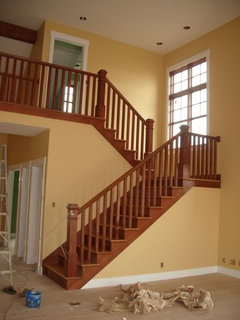
Another photo with all wood and white stringers:
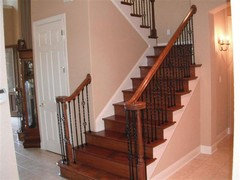
chispa
8 years agoDon't settle. To me it sounds like you had it specified on your plan and the builder quoted it that way on the contract ... for some reason he is now trying to pretend it is a typo!! Don't settle!
njbuilding143
Original Author8 years agolast modified: 8 years agoChispa - Thanks for the vote of confidence.. I just don't see how I could settle.. I mean yes, if he meant something different I feel sorry.. But this is what you told me that you were giving me.. How would I have expected something different? Maybe he should have been more detailed in his description... Or maybe he should have called a meeting to ensure we were both on the same page.. But honestly, even if we caught this prior to them being installed I would still expect everything to be oak.. From the little research I have done online regarding price differences between oak and pine I am seeing that oak is about 3x more expensive then the equivalent item in pine.. So this was a huge area of savings for them by going this route.. And if they truly meant (and not lying) that they intended on doing the stairs with pine then this is a large cost difference..
bry911
8 years agolast modified: 8 years agoThe options for that stair case are "oak treads, risers, cap AND spindles" If it said "carpeted treads, risers, cap AND spindles," would you expect them to make you carpeted spindles? I am sorry, although your verbiage is very common, it is not proper grammar and while that doesn't mean you are in the wrong, it does mean it is not clear.
Edit: My grammar is terrible. I pay an editor for my papers because I suck at it. So I am really not trying to be critical, I am just pointing out the problem.
njbuilding143
Original Author8 years agoBry911.. I understand what you are saying and I get your exaggerated example.. The issue is that there is no distinction in the wood.. I get that you are pointing out that they used improper grammar, but the fact remains that based on the wording they should be using oak.. And technically in your example an owner could argue for carpet covered spindles.. The chance that you would want that is slim, but if that is the way its worded then it is what it is.. But let me ask you this.. If you signed a contract for jewelry and it said "provide 24k gold necklace, bracelet, watch, ring, and earings", would you expect any of it to be 18k gold, silver, or any other material? No.. You would expect everything to be 24k gold.. Well this is exactly the same scenario.. I completely understand that THEY may have made a mistake and intended the stairs to be oak treads with pine risers, but is this something that I should pay for? As an owner of a company you sometimes have to pay up for mistakes..
bry911
8 years agolast modified: 8 years agoWhy bother asking. If you are going to take the answers that you want and nothing else, then do that. I am telling you that it doesn't say what you are understanding it to say. My example isn't exaggerated, it is the same thing you are saying, that an adjective as part of a list modifies the entire list. That is patently not true. In fact, to modify the list you would have to use a colon between the adjective and the list. You ask why it would not specify other types of wood if it meant other types and the answer would simply be that it is typical to specify the treads in stairs and not typical to specify the risers as they are painted white. There are so many gray areas in a contract that things like this happen all the time. Contracts almost always default to industry or area standards.
The bottom line is: this is a textbook example of a vague clause in a contract. In fact, this is almost exactly like the example they used in contract law. Will you win? Maybe, I mean it is not like you are going to court over it. But you got advice to see an attorney and I am telling you what he is going to say. I am not telling you to let it go, or that he is not going to pay, I am just telling you that running to your attorney maybe should be your second or third choice.
By the way the second picture you posted above would not work for your position. The spindles are not oak. My original statement was simply are all other parts oak? Specifically are your spindles oak? If so, you might have a stronger case. If not, you have a weaker case.
njbuilding143
Original Author8 years agoBry911 - I do appreciate all the input you have provided as it gives an alternate view of the situation.. While I may not agree with it, it does help to see how some may view it.. The fact is that even the project manager agreed that without having "inside" knowledge of how they do things it appears as though it should be a full oak staircase.. I expressed my disappoint with the difference in what was worded and what was provided and he said he was going to speak with the builders again.. He even commented "well a staircase like this in all oak would have been a fortune, probably like 15k".. At that point I told him that this is why we chose their company as they were a higher price but their proposal had higher end thinks like this.. He said he was going to speak with the owners again to try and see what can be done about this..
User
8 years agoYes, we have all read 'Eats, Shoots & Leaves' tyvm...
The intent should be the plan documents. It seems those are more clear. Though my contractor had a habit of ignoring them.
GCs will build in contingencies into the line items to account for some things like this. I would insist on the oak.
User
8 years agolast modified: 8 years agoAre you sure you want an all oak staircase in a house with painted trim?
The stair photos you posted are great examples. I believe they are renovations where an older house with dark woodwork has been updated with new finishes and painted trim but the stair was left untouched creating an awkward juxtaposition of finishes. Notice the old fashioned "shoe" molding at the wall base of the second example and the awkwardness of the sharp transition from painted to stained wood at the mitered corner between the riser and the finished stringer.
In new construction trim is carefully coordinated to avoid this kind of awkwardness. I believe it is clear that the intent of the design was for painted risers and someone failed to write a proper spec to describe it.
Oaktown
8 years agolast modified: 8 years agoSorry to hear about the disconnect with your builder.
[Just a minor clarification on the legal stuff for future readers. A legal interpretation will be very fact specific. A court can look to industry standards and practice to help determine whether contract language is ambiguous (especially as to jargon/technical terms). If contract language is determined to be ambiguous, generally it will be construed against the drafter, especially where the drafter has superior bargaining power, experience, etc. In this particular instance it might be a distinction without a difference -- or not.]
bry911
8 years agoIf contract language is determined to be ambiguous, it generally is construed against the drafter, especially where the drafter has superior bargaining power, experience, etc. In this particular instance it might be a distinction without a difference, but in other situations it could matter.
I am not sure I agree with your interpretation. Generally, speaking courts side against the drafter when there is unequal bargaining power, experience, etc. While courts have decided against the drafter far more than vice versa this is also a side effect of the fact that the drafter is far more likely to have greater bargaining power in a contract situation. Thus it is important to note that bargaining power in a multiple bid situation is generally considered to be with the buyer and not the bidder. Also, if both parties are represented by attorneys it often negates bargaining power. In those situations courts will simply render the decision to the best of their ability, ie...actions of the parties, industry standards, etc.
This is why I keep asking are the spindles oak. Since spindles would commonly be white in a stair with painted pine risers it is convincing evidence that the builder intended the entire staircase to be oak (actions of the parties.)
Oaktown
8 years agobry911, I'm just pointing out the order in which courts are supposed to address the questions, and where the burden lies generally. njbuilding, sorry for the OT.
User
8 years agoDon't let a design don't drive this decision. As Sanford notes above, remodel compromises are not a good standard by which to set the bar for new construction.
jemdandy
8 years agoI think the contractor goofed on the wording. The usual construction for a first floor to 2nd floor stair is hardwood treads with softer wood for the risers, but wording used indicates oak for both.
The work is done and has nice appearance. See if you can work out a cost reduction to leave it as is. Re-work would be very expensive and the drywall might have to be patched and repainted. To make your point, contact the bank holding the construction loan and put a freeze on any draws until this issue has been resolved.User
8 years agolast modified: 8 years agoThe irony of this situation is that the contractor's "verbiage" mistake might force him to build an all oak staircase that will look like a design mistake in a house with painted trim.
Just because a design option costs more doesn't necessarily mean it will be better. I was taught and I strongly believe it is true that the most effective approach to architectural design is to choose a major idea or theme and then support it with as many elements as possible. This is often the most distinguishing aspect of professional design not that it is simple or easy to accomplish.
Unless there is something unusual about the house that has not been revealed, this looks to me like an opportunity to strengthen the interior design of the house. But, of course, it would help to see what the stair looks like.
I'm curious to know if the stringers will be oak since they were not included in the contract description.
njbuilding143
Original Author8 years agoSanford - I get what you are saying.. But at this point while we could "go with" the staircase that is installed, it doesn't take away from the fact of what our impression was when we signed this contract and the wording.. Sure, we could just do this stair case and honestly I think it would look very elegant with the white painted risers.. I have seen the pics and it does look very nice.. BUT, we were under the impression when we signed our contract, based on what the owner put down, that we would be getting a full oak staircase.. The price that we agreed on for the construction of this house was based on having a full oak staircase installed.. From what I am getting from the project manger (have not heard directly from owner yet) the owner is not budging.. Project manager claims that the owner meant for the stairs to just have oak treads and that his mistake in the wording is just that, a mistake.. I explained to the project manager that their bid was higher then some of the others and our impression was because it was that they used higher end materials and provided things such as this full oak staircase.. The project manager said that he understood the contract as having painted risers BUT said that is only because that is what they are used to doing.. He admitted that based on the way the wording is in the contract it reads that it is a full oak staircase.. I told the project manager that the owner can contact me directly so we can discuss this further and also advised that we would be speaking to the bank about this discrepancy.. I understand that they obviously do not want to just "throw away" this staircase and have to come out of pocket for a new oak staircase.. BUT there should be some way to work this out.. They shouldn't just throw this to the side and this is a huge mistake on their part.. Unfortunately when it comes to contracts you are held to them, regardless of what you "meant".. We feel that we are an easy going couple and think we have been more then fair with this company after all of the blunders they have made with this project.. This just happens to be a very costly mistake and something that I don't think I can just let go.. Even the project manager admitted that the cost difference is huge between what we got and what the contract says.. I will keep you updated on what ends up happening with the owner.. Something tells me this is going to be a strict back and forth and may end up going to court.. Not sure what kind of cost is associated with the staircase we received, however the project manager said that our staircase, if done in all oak as per contract, it would have been around 15k.. I know nothing about stairs so I have no idea how true that is..
User
8 years agolast modified: 8 years agoThe estimate of $15,000 is obviously grossly exaggerated. If you base your claim on the exact wording of the contract, the contractor only has to replace the risers (like in your example photo) and substitute oak spindles which might cost him $1,500. If you want oak stringers you might have to pay an additional $3,000 or more. In the end, if you put a carpet runner on the stairs, the oak risers will probably just look odd.
I know you feel the contractor has put one over on you but you should be focusing on the design of the house instead of making a point in an on going conflict. I recommend that you ask for a credit toward another issue. You should make it attractively low to ensure that the contractor takes it. You don't want to enforce a contract error that hurts both parties.

mushcreek
8 years agoWe're talking oak, not gold. There's not that much cost involved- maybe a few hundred dollars extra for oak. A staircase is all labor; the materials aren't that much. If you look at oak at a big box store, the prices are crazy, but from a real lumber supplier, it simply doesn't cost that much. Now, if they do sloppy work and fill in the voids with gallons of caulk, then paint saves a lot of money, as you can't hide poor workmanship when finishing bright.
bry911
8 years agolast modified: 8 years agoI think I am doing a bad job at getting my point across, so I am going to try a different approach. I think you should stand your ground, I just don't think you should stand so righteously upon your ground. Your contract is vague. Even if it says exactly what you are purporting it to say and everyone agrees that is what it says, you didn't specify the grade of oak, in fact, you didn't even specify stain grade oak. Now to some extent you are saved by the fact that no one finger joints oak (you can find it but it is rare and not worth the trouble), so the lowest grade you are likely to end up with is 2ac, which will still look like crap, but will save the builder some money.
I admit that I am making an assumption, in spite of what we all know about assumptions. But if the rest of your contract is similarly vague this is not the last time you and the builder are going to disagree, at some point you are going to have to lose a few of these fights. If not you will most likely lose in other ways. You probably saved a lot of money by not having the architect do exhaustive spec sheets to include in the contract, but part of that savings gets eaten up by things like this.
Just my 2 cents, do what you want.
User
8 years agoThe additional material cost for 16 red oak risers instead of select pine is about $50. (To reduce denting I would use primed white poplar which would cost about $60 more than oak.) The additional cost of 32 turned red oak balusters instead of poplar is about $128 so with a bit extra for installation and finishing mushcreek's estimate of a few hundred dollars is a good one.
You can force the contractor to make the change to oak but if you accept the stair, you can only ask to be compensated for the difference in the original cost of materials; you cannot profit from his mistake. However, if you intent to argue and possibly delay the project, the contractor might be forced to offer a larger settlement.
If you were my client, to avoid ending up with an ordinary and possibly odd looking builder designed oak staircase, I would advise you to accept the stair as is and insist on a higher quality painted poplar balustrade and oak handrail. (I would use a mahogany handrail) That would more than use up any reasonable settlement amount and give you a nicer stair than you should have expected.
njbuilding143
Original Author8 years agoSanford - Just so I have it right you would ask to upgrade just the balusters to painted poplar and oak rail? Someone mentioned that they could do a "veneer" over the current risers which if the builder was going to do anything that might be what he goes for instead of redoing the stairs.. I looked online and saw this is something that is usually done when people redo their stairs as they just lay new treads and risers over existing.. One of our concerns if we stay with this staircase and work it out is that with kids on the way these current pine risers are going to be getting scuffed and damaged running up and having feet kicking the back.. I know pine is considered a "soft" wood which is easy to damage.
millworkman
8 years agoProbably 80% of the stair risers in new construction is some variation of white pine. If your kids inflict damage to the risers running up and down stairs you need to speak to them as oak would get beat up pretty bad as well. As for all oak stairs including balusters and railings personally I do not like the look, just too much oak. As far as veneer risers, forget it if you think your kids will be kicking it as that will hold up less than any pine.
User
8 years agolast modified: 8 years agoStair risers that take a beating are usually above short treads. A 10" tread with a 3/4" nosing shouldn't be a problem for children's shoes.
If you have young children, you should definitely add a carpet runner to the stairs for noise as well as safety.
Adding a veneer would be a big mistake IMO. The difficulty is the joint at the stringer if one side is open ... but you haven't shown us the stair design so we don't know if that is even an issue. Designing by pieces without looking at the whole always produces disappointing results. This is the result of both you and the builder thinking about general features instead of the details.
The most important issue here is the nature of the stringers and that has not been addressed either by the contract or by this discussion.
A well designed stair with painted risers, etc, should cost far more than a builder designed all-oak stair. (No offense to builders intended) This problem should be thought of as an opportunity to get a better stairway at no additional expense.
Here is a stair with oak treads and a mahogany handrail with painted risers, balustrades and stringers. The cost was probably over $50,000 but no one added it up. I'm not suggesting this stair for your house but to show you that there is no reason to think of an all-oak stair as an "upgrade" to one with painted trim.
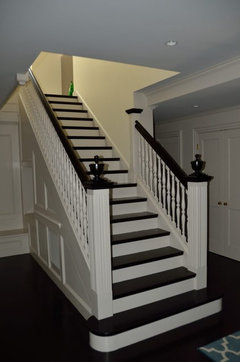
njbuilding143
Original Author8 years agoSanford - Appreciate the input.. That staircase does look very nice..
Here is a quick picture of what the stairs currently look like.. Not
sure if this helps with what you are looking to find out about the
stairs:

User
8 years agolast modified: 8 years agoIt appears to be excellent workmanship and the risers appear to be hard pine so they will be as serviceable as oak and far more elegant IMO. I would leave it as is and upgrade to a mahogany handrail and make sure the support post is well designed. Do you have a drawing or photo of it?

cpartist
8 years agoSometimes you can win the battle but still lose the war. I think Sanford offered you a good solution and your stair so far looks awesome.
njbuilding143
Original Author8 years agolast modified: 8 years agoSanford - our design idea was to have a swirl style end post on both sides.. I believe it is called "volute".. I don't have "inspiration" photos on my phone but here are the plans.. By the way you can note how the plans called for oak treads and risers.. Not trying to get back into our initial debate.. But just saying that it was on the plans like that and then in the contract you can see how we would expect it to be oak for both risers and treads....
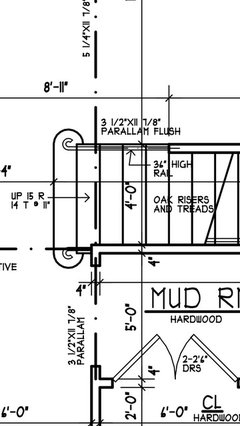
User
8 years agolast modified: 8 years agoIt is unwise to show riser and tread materials on the drawings and also in the specifications. But wherever that information is located, it should also include the materials for the stringers and handrails.
Unless your house is trimmed in oak, you have an opportunity to use painted trim at the stair that would be more appropriate for a colonial handrail volute. To reinforce that design tradition you should make the handrails mahogany. Mahogany is no darker than oak so the finished color can be similar or darker (more traditional) than the flooring and treads. I would also simplify the balusters as shown below.
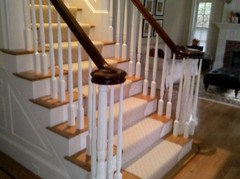

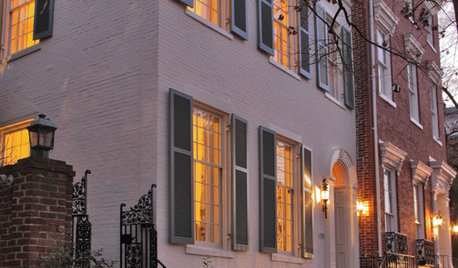
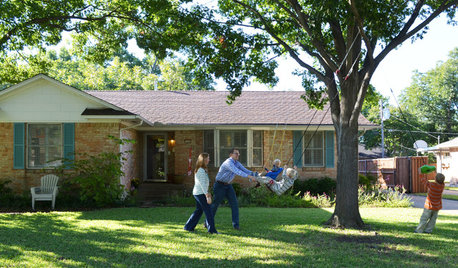
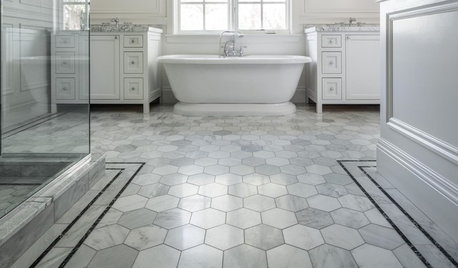

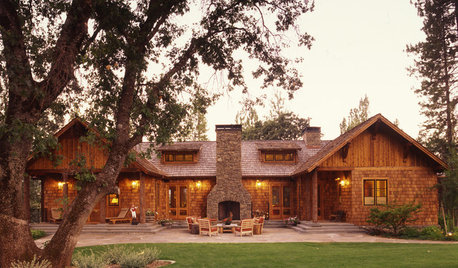
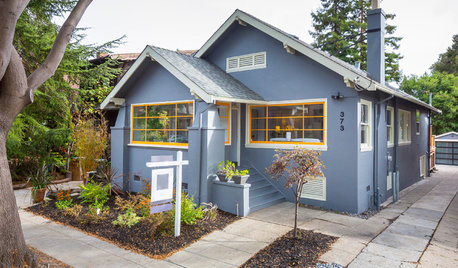
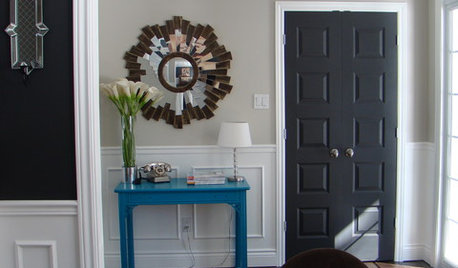
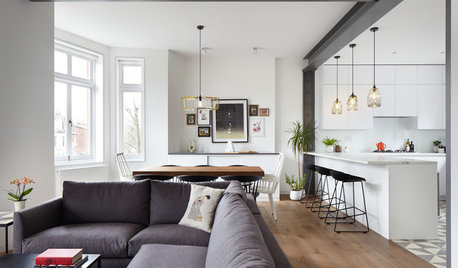








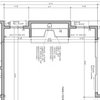
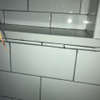
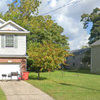
Virgil Carter Fine Art